Joel Shor
Predicting Generalization of AI Colonoscopy Models to Unseen Data
Mar 22, 2024



Abstract:$\textbf{Background}$: Generalizability of AI colonoscopy algorithms is important for wider adoption in clinical practice. However, current techniques for evaluating performance on unseen data require expensive and time-intensive labels. $\textbf{Methods}$: We use a "Masked Siamese Network" (MSN) to identify novel phenomena in unseen data and predict polyp detector performance. MSN is trained to predict masked out regions of polyp images, without any labels. We test MSN's ability to be trained on data only from Israel and detect unseen techniques, narrow-band imaging (NBI) and chromendoscoy (CE), on colonoscopes from Japan (354 videos, 128 hours). We also test MSN's ability to predict performance of Computer Aided Detection (CADe) of polyps on colonoscopies from both countries, even though MSN is not trained on data from Japan. $\textbf{Results}$: MSN correctly identifies NBI and CE as less similar to Israel whitelight than Japan whitelight (bootstrapped z-test, |z| > 496, p < 10^-8 for both) using the label-free Frechet distance. MSN detects NBI with 99% accuracy, predicts CE better than our heuristic (90% vs 79% accuracy) despite being trained only on whitelight, and is the only method that is robust to noisy labels. MSN predicts CADe polyp detector performance on in-domain Israel and out-of-domain Japan colonoscopies (r=0.79, 0.37 respectively). With few examples of Japan detector performance to train on, MSN prediction of Japan performance improves (r=0.56). $\textbf{Conclusion}$: Our technique can identify distribution shifts in clinical data and can predict CADe detector performance on unseen data, without labels. Our self-supervised approach can aid in detecting when data in practice is different from training, such as between hospitals or data has meaningfully shifted from training. MSN has potential for application to medical image domains beyond colonoscopy.
The unreasonable effectiveness of AI CADe polyp detectors to generalize to new countries
Dec 17, 2023Abstract:$\textbf{Background and aims}$: Artificial Intelligence (AI) Computer-Aided Detection (CADe) is commonly used for polyp detection, but data seen in clinical settings can differ from model training. Few studies evaluate how well CADe detectors perform on colonoscopies from countries not seen during training, and none are able to evaluate performance without collecting expensive and time-intensive labels. $\textbf{Methods}$: We trained a CADe polyp detector on Israeli colonoscopy videos (5004 videos, 1106 hours) and evaluated on Japanese videos (354 videos, 128 hours) by measuring the True Positive Rate (TPR) versus false alarms per minute (FAPM). We introduce a colonoscopy dissimilarity measure called "MAsked mediCal Embedding Distance" (MACE) to quantify differences between colonoscopies, without labels. We evaluated CADe on all Japan videos and on those with the highest MACE. $\textbf{Results}$: MACE correctly quantifies that narrow-band imaging (NBI) and chromoendoscopy (CE) frames are less similar to Israel data than Japan whitelight (bootstrapped z-test, |z| > 690, p < $10^{-8}$ for both). Despite differences in the data, CADe performance on Japan colonoscopies was non-inferior to Israel ones without additional training (TPR at 0.5 FAPM: 0.957 and 0.972 for Israel and Japan; TPR at 1.0 FAPM: 0.972 and 0.989 for Israel and Japan; superiority test t > 45.2, p < $10^{-8}$). Despite not being trained on NBI or CE, TPR on those subsets were non-inferior to Japan overall (non-inferiority test t > 47.3, p < $10^{-8}$, $\delta$ = 1.5% for both). $\textbf{Conclusion}$: Differences that prevent CADe detectors from performing well in non-medical settings do not degrade the performance of our AI CADe polyp detector when applied to data from a new country. MACE can help medical AI models internationalize by identifying the most "dissimilar" data on which to evaluate models.
Clinical BERTScore: An Improved Measure of Automatic Speech Recognition Performance in Clinical Settings
Mar 13, 2023

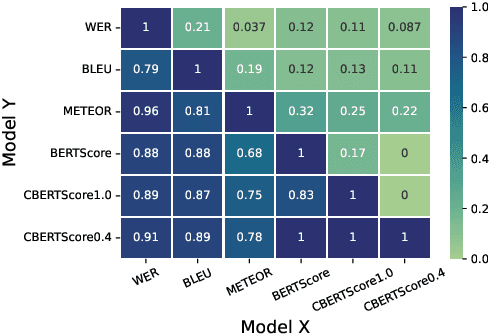
Abstract:Automatic Speech Recognition (ASR) in medical contexts has the potential to save time, cut costs, increase report accuracy, and reduce physician burnout. However, the healthcare industry has been slower to adopt this technology, in part due to the importance of avoiding medically-relevant transcription mistakes. In this work, we present the Clinical BERTScore (CBERTScore), an ASR metric that penalizes clinically-relevant mistakes more than others. We demonstrate that this metric more closely aligns with clinician preferences on medical sentences as compared to other metrics (WER, BLUE, METEOR, etc), sometimes by wide margins. We collect a benchmark of 13 clinician preferences on 149 realistic medical sentences called the Clinician Transcript Preference benchmark (CTP), demonstrate that CBERTScore more closely matches what clinicians prefer, and release the benchmark for the community to further develop clinically-aware ASR metrics.
Knowledge distillation for fast and accurate DNA sequence correction
Nov 17, 2022



Abstract:Accurate genome sequencing can improve our understanding of biology and the genetic basis of disease. The standard approach for generating DNA sequences from PacBio instruments relies on HMM-based models. Here, we introduce Distilled DeepConsensus - a distilled transformer-encoder model for sequence correction, which improves upon the HMM-based methods with runtime constraints in mind. Distilled DeepConsensus is 1.3x faster and 1.5x smaller than its larger counterpart while improving the yield of high quality reads (Q30) over the HMM-based method by 1.69x (vs. 1.73x for larger model). With improved accuracy of genomic sequences, Distilled DeepConsensus improves downstream applications of genomic sequence analysis such as reducing variant calling errors by 39% (34% for larger model) and improving genome assembly quality by 3.8% (4.2% for larger model). We show that the representations learned by Distilled DeepConsensus are similar between faster and slower models.
The Need for Medically Aware Video Compression in Gastroenterology
Nov 02, 2022



Abstract:Compression is essential to storing and transmitting medical videos, but the effect of compression on downstream medical tasks is often ignored. Furthermore, systems in practice rely on standard video codecs, which naively allocate bits between medically relevant frames or parts of frames. In this work, we present an empirical study of some deficiencies of classical codecs on gastroenterology videos, and motivate our ongoing work to train a learned compression model for colonoscopy videos. We show that two of the most common classical codecs, H264 and HEVC, compress medically relevant frames statistically significantly worse than medically nonrelevant ones, and that polyp detector performance degrades rapidly as compression increases. We explain how a learned compressor could allocate bits to important regions and allow detection performance to degrade more gracefully. Many of our proposed techniques generalize to medical video domains beyond gastroenterology
TRILLsson: Distilled Universal Paralinguistic Speech Representations
Mar 20, 2022

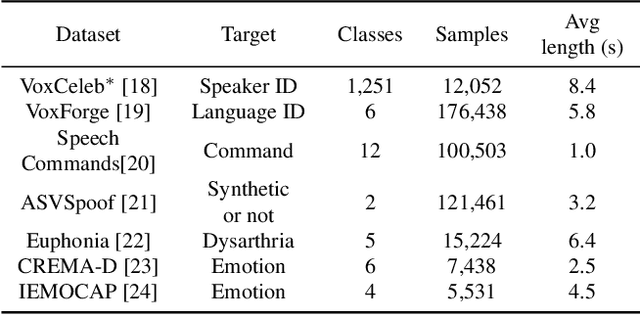
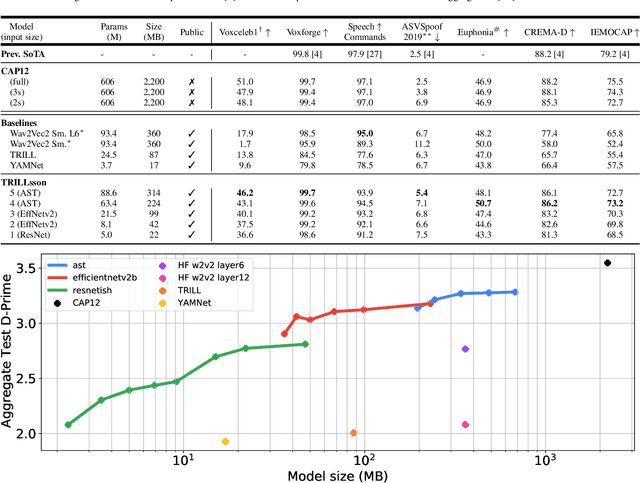
Abstract:Recent advances in self-supervision have dramatically improved the quality of speech representations. However, deployment of state-of-the-art embedding models on devices has been restricted due to their limited public availability and large resource footprint. Our work addresses these issues by publicly releasing a collection of paralinguistic speech models that are small and near state-of-the-art performance. Our approach is based on knowledge distillation, and our models are distilled on public data only. We explore different architectures and thoroughly evaluate our models on the Non-Semantic Speech (NOSS) benchmark. Our largest distilled model is less than 15% the size of the original model (314MB vs 2.2GB), achieves over 96% the accuracy on 6 of 7 tasks, and is trained on 6.5% the data. The smallest model is 1% in size (22MB) and achieves over 90% the accuracy on 6 of 7 tasks. Our models outperform the open source Wav2Vec 2.0 model on 6 of 7 tasks, and our smallest model outperforms the open source Wav2Vec 2.0 on both emotion recognition tasks despite being 7% the size.
Universal Paralinguistic Speech Representations Using Self-Supervised Conformers
Oct 09, 2021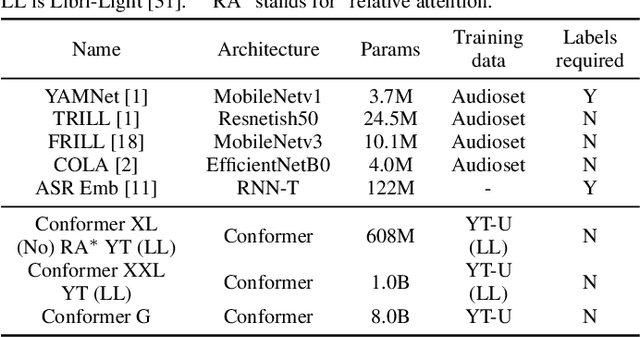
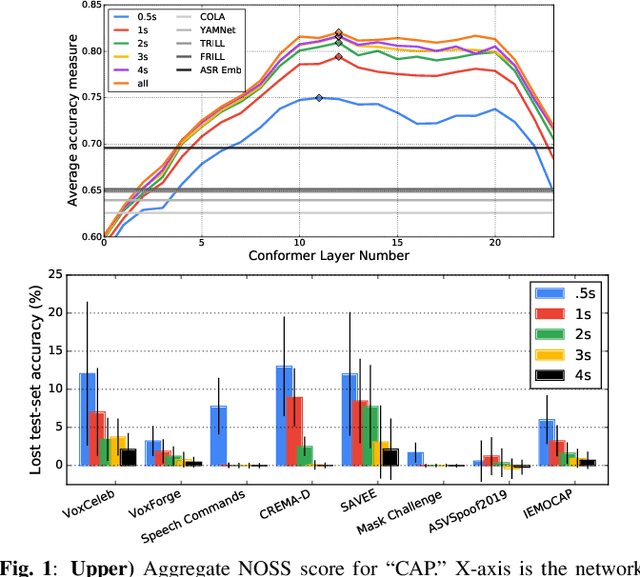
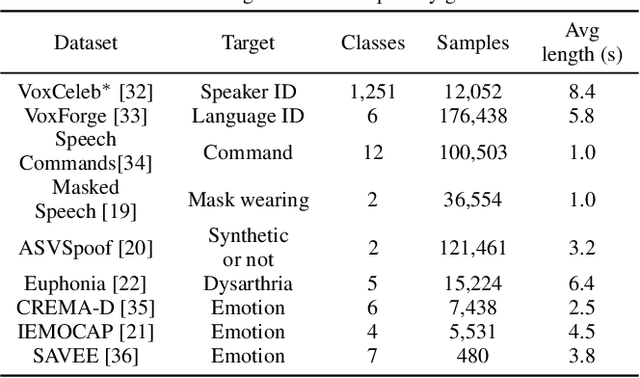
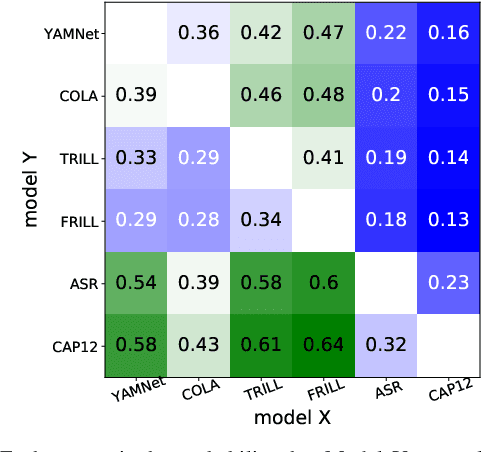
Abstract:Many speech applications require understanding aspects beyond the words being spoken, such as recognizing emotion, detecting whether the speaker is wearing a mask, or distinguishing real from synthetic speech. In this work, we introduce a new state-of-the-art paralinguistic representation derived from large-scale, fully self-supervised training of a 600M+ parameter Conformer-based architecture. We benchmark on a diverse set of speech tasks and demonstrate that simple linear classifiers trained on top of our time-averaged representation outperform nearly all previous results, in some cases by large margins. Our analyses of context-window size demonstrate that, surprisingly, 2 second context-windows achieve 98% the performance of the Conformers that use the full long-term context. Furthermore, while the best per-task representations are extracted internally in the network, stable performance across several layers allows a single universal representation to reach near optimal performance on all tasks.
BigSSL: Exploring the Frontier of Large-Scale Semi-Supervised Learning for Automatic Speech Recognition
Oct 01, 2021
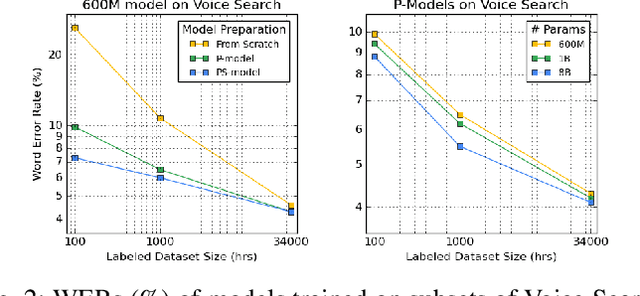
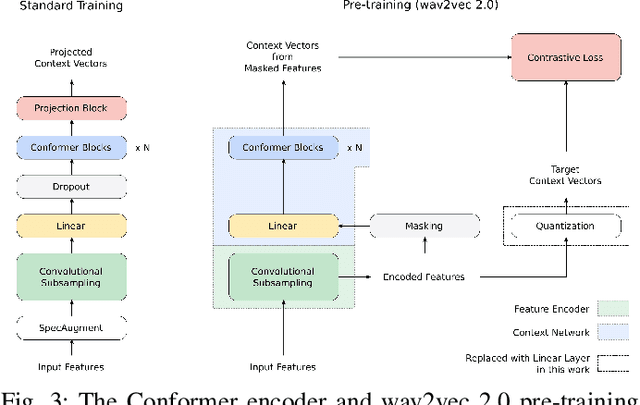
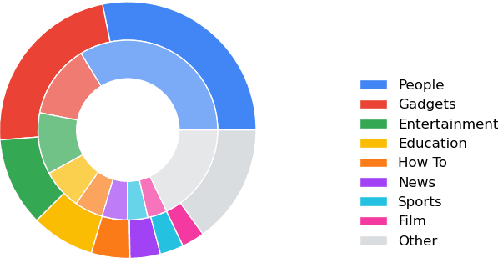
Abstract:We summarize the results of a host of efforts using giant automatic speech recognition (ASR) models pre-trained using large, diverse unlabeled datasets containing approximately a million hours of audio. We find that the combination of pre-training, self-training and scaling up model size greatly increases data efficiency, even for extremely large tasks with tens of thousands of hours of labeled data. In particular, on an ASR task with 34k hours of labeled data, by fine-tuning an 8 billion parameter pre-trained Conformer model we can match state-of-the-art (SoTA) performance with only 3% of the training data and significantly improve SoTA with the full training set. We also report on the universal benefits gained from using big pre-trained and self-trained models for a large set of downstream tasks that cover a wide range of speech domains and span multiple orders of magnitudes of dataset sizes, including obtaining SoTA performance on many public benchmarks. In addition, we utilize the learned representation of pre-trained networks to achieve SoTA results on non-ASR tasks.
Comparing Supervised Models And Learned Speech Representations For Classifying Intelligibility Of Disordered Speech On Selected Phrases
Jul 08, 2021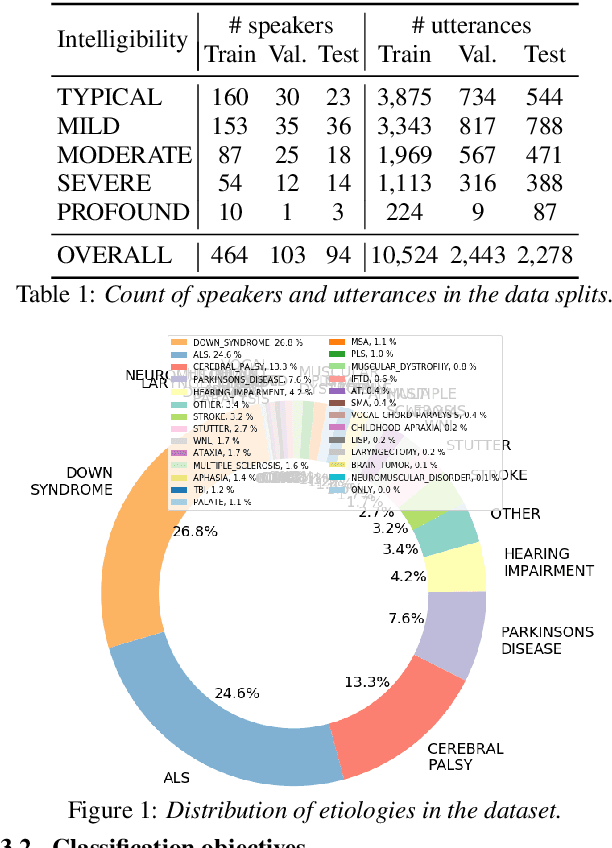
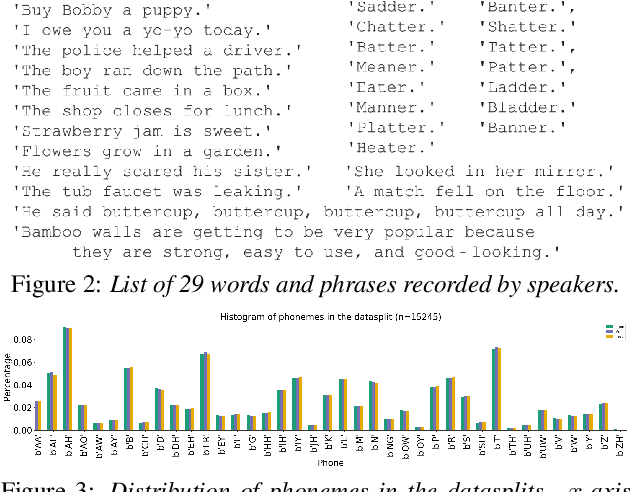
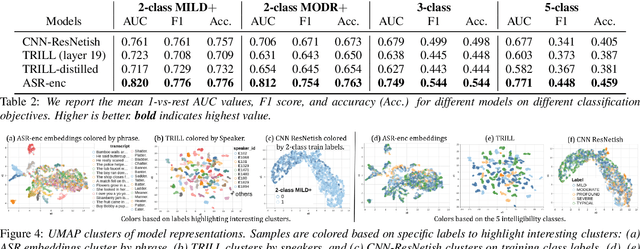
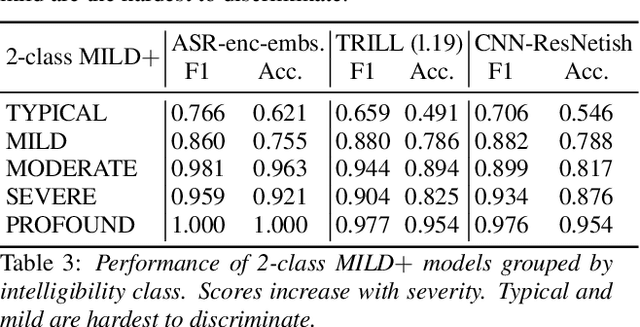
Abstract:Automatic classification of disordered speech can provide an objective tool for identifying the presence and severity of speech impairment. Classification approaches can also help identify hard-to-recognize speech samples to teach ASR systems about the variable manifestations of impaired speech. Here, we develop and compare different deep learning techniques to classify the intelligibility of disordered speech on selected phrases. We collected samples from a diverse set of 661 speakers with a variety of self-reported disorders speaking 29 words or phrases, which were rated by speech-language pathologists for their overall intelligibility using a five-point Likert scale. We then evaluated classifiers developed using 3 approaches: (1) a convolutional neural network (CNN) trained for the task, (2) classifiers trained on non-semantic speech representations from CNNs that used an unsupervised objective [1], and (3) classifiers trained on the acoustic (encoder) embeddings from an ASR system trained on typical speech [2]. We found that the ASR encoder's embeddings considerably outperform the other two on detecting and classifying disordered speech. Further analysis shows that the ASR embeddings cluster speech by the spoken phrase, while the non-semantic embeddings cluster speech by speaker. Also, longer phrases are more indicative of intelligibility deficits than single words.
Towards Learning a Universal Non-Semantic Representation of Speech
Mar 02, 2020
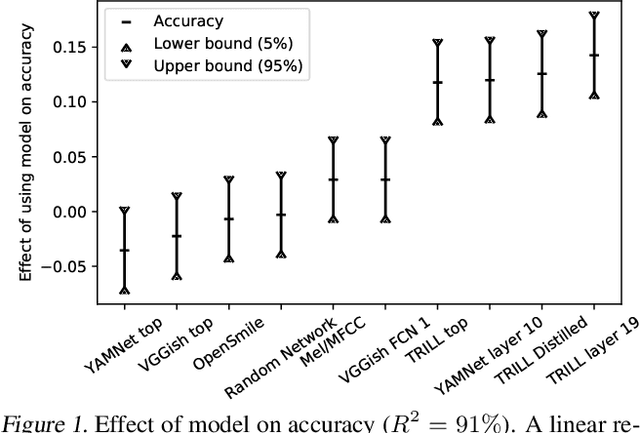
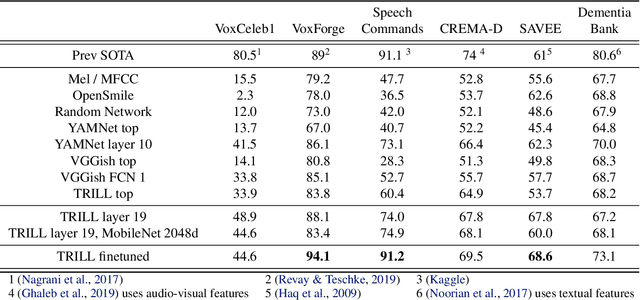
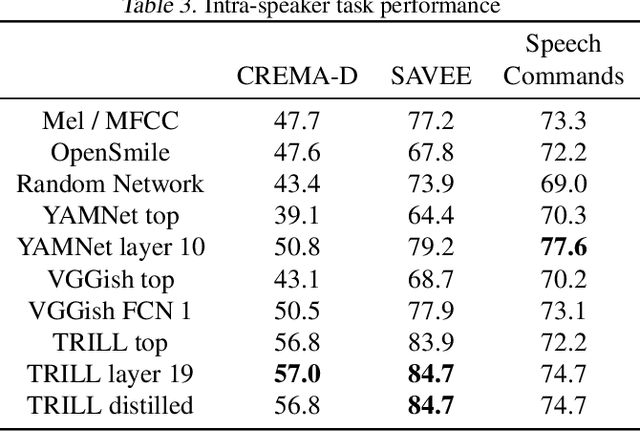
Abstract:The ultimate goal of transfer learning is to reduce labeled data requirements by exploiting a pre-existing embedding model trained for different datasets or tasks. While significant progress has been made in the visual and language domains, the speech community has yet to identify a strategy with wide-reaching applicability across tasks. This paper describes a representation of speech based on an unsupervised triplet-loss objective, which exceeds state-of-the-art performance on a number of transfer learning tasks drawn from the non-semantic speech domain. The embedding is trained on a publicly available dataset, and it is tested on a variety of low-resource downstream tasks, including personalization tasks and medical domain. The model will be publicly released.
 Add to Chrome
Add to Chrome Add to Firefox
Add to Firefox Add to Edge
Add to Edge